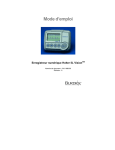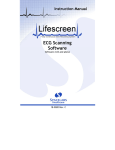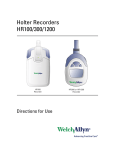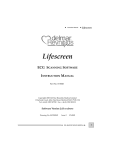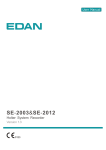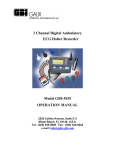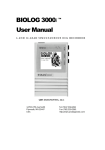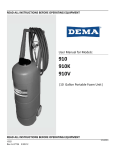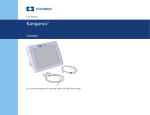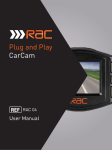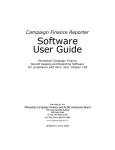Download - Infiniti Medical
Transcript
Instruction and Technical Manual evo Recorder and Docking Station evo Recorder firmware version 2.xx evo Docking Station firmware version 1.xx 50-0037 Rev B Instruction and Technical Manual 1 2 50-0037 Rev B Contents 1. 2. INTRODUCTION 5 1.1 1.2 About this Manual Disclaimer 5 5 SAFETY AND REGULATORY 7 2.1 2.2 2.3 2.4 2.5 2.6 2.7 2.8 2.9 2.10 2.11 2.12 2.13 2.14 3. 4. Page Device Description Indications and Intended Use Contraindications Precautions Warning Adverse Reactions Caution Conformance to Standards Adjustment, Replacement of Parts, Maintenance & Repair Defects and Abnormal Stresses Modifications Declaration of Conformity Explanation of Markings Manufacturer 7 9 10 10 10 10 10 11 11 11 12 12 12 13 DETAILED OPERATING INSTRUCTIONS 15 3.1 3.2 3.3 3.4 3.5 3.6 3.7 3.8 3.9 3.10 3.11 3.12 3.13 15 15 15 16 16 18 19 20 22 23 24 25 26 First-time Use Minimum Software Versions Manual Recording Identification Recording Procedure Overview Prepare the Recorder Prepare the Patient Apply the Electrodes Hook up the Recorder Check the ECG Quality Instruct the Patient On the Patient’s Return Download the Recording Analyse the Recording MAINTENANCE 27 4.1 4.2 4.3 27 28 29 Cleaning and Disinfecting the evo Recorder Dynamic Energy Source Replacement Kit evo Recorder Accessories and Consumables Instruction and Technical Manual 3 5. 6. TECHNICAL MANUAL 31 5.1 5.2 5.3 5.4 5.5 5.6 5.7 5.8 5.9 31 33 34 34 34 34 35 35 36 evo Recorder Technical Specifications evo Docking Station Technical Specifications evo Error Messages Software Error Messages and Warnings Firmware Update Utility Installation of the Docking Station Infrared Data Transfer User Labelling of the Recorder User labelling of the docking station INDEX 37 Copyright 2008 Spacelabs Healthcare Ltd. 1 Harforde Court, John Tate Road, Hertford SG13 7NW 4 50-0037 Rev B 1. INTRODUCTION 1.1 About this Manual This manual contains detailed operating instructions for the evo Holter ECG recorder and the evo docking station. It is one of 3 manuals for this recorder. • evo Recorder Instruction and Technical Manual • evo Recorder Quick Guide – Sentinel Users • evo Recorder Quick Guide – CardioNavigator Plus This manual has 6 chapters: Chapter 1 Introduction Chapter 2 Safety and Regulatory Chapter 3 Detailed Operating Instructions Chapter 4 Maintenance Chapter 5 Technical Manual Chapter 6 Index 1.2 Disclaimer Every effort has been taken to ensure the accuracy of this manual but Spacelabs Healthcare cannot take liability for consequences caused by errors or omissions. You are advised to check with Spacelabs Healthcare on any point on which you are unsure or need confirmation. Instruction and Technical Manual 5 This page is intentionally blank. 6 50-0037 Rev B 2. SAFETY AND REGULATORY 2.1 Device Description The evo recorder is a compact, lightweight three channel Holter Ambulatory ECG recorder utilizing a digital storage technique to store the ECG recording onto an internal flash memory. This recorder provides continuous monitoring of 3 leads of ECG for 24 hours or 48 hours. The on board display allows the user to monitor the ECG and pacing detection during hook-up. Pacing detection is always enabled on all 3 channels. It is important to verify the ECG quality before starting the recording. Menu navigation is controlled by the single button on the front of the recorder. This button also acts as a Patient Event button when Recording Mode is active. This enables the patient to indicate symptomatic episodes in the recording for correlation with the Patient Diary. Four separate lead wires with color coded snap leads are used to connect the electrodes on the chest to the recorder. The internal Dynamic Energy Source is automatically re-energized when each recording is downloaded into the Holter Analyser via the docking station. Recordings may be analyzed using an Impresario Holter analyzer in conjunction with the Sentinel Cardiology Information Management software. The recorder is also compatible with the CardioNavigator Plus database used in conjunction with Impresario scanners. evo Front View Instruction and Technical Manual 7 evo Top View evo Rear View Docking Station Rear View 8 50-0037 Rev B evo placed in Docking Station 2.2 Indications and Intended Use The evo Holter recorder is to be used for the non-invasive ambulatory recording of three channel electrocardiograms on an internal, non removable flash memory. The recorder allows data to be collected over a continuous period of up to 48 hours while allowing the subject to perform most of their normal daily activities. No analysis is performed by the evo recorder; the recordings can be analyzed on compatible Holter analysis systems from Spacelabs Healthcare This device has been designed and supplied specifically for the long term recording of electrocardiograms in ambulatory patients using standard Holter monitoring techniques. It shall not be used for any other purposes. The device shall only be operated by suitably competent personnel trained in the use and procedures of Holter electrocardiography for diagnostic purposes. Instruction and Technical Manual 9 2.3 Contraindications None known. 2.4 Precautions Follow the cleaning instructions for reasons of basic hygiene and to reduce the risk of cross-infection. The evo recorder is not intended for use on infants weighing less than 10 Kg. Under normal operating conditions, the recorder may feel slightly warm upon removal from the docking station. During patient hook-up, ensure that the electrodes do not come into contact with other metal parts or ground. 2.5 Warning This device must not be used for direct cardiac application. Never attempt to connect any other device or instrument to the internal connections or circuitry of the evo recorder while it is connected to a subject. 2.6 Adverse Reactions Patients may suffer allergic skin reactions from the adhesive of the electrodes, causing reddening, soreness or irritation. Ask the patient if they suffer from these allergies. Contact the electrode provider for further specific information. 2.7 Caution Federal (USA) law restricts this device to sale by or on the order of a medical practitioner licensed by the law of the State in which he practices to use or order the use of the device. 10 50-0037 Rev B 2.8 Conformance to Standards According to ANSI/AAMI EC38:1998, the evo recorder is a Type 1 ambulatory ECG device. This device has been designed in accordance with EN60601 -1, “Medical electrical equipment, Part 1: General requirements for safety”, as follows: 1. EQUIPMENT with an INTERNAL ELECTRICAL POWER SOURCE. 2. EQUIPMENT having a TYPE BF APPLIED PART. 3. ORDINARY EQUIPMENT, without protection against ingress of liquid. 4. Not suitable for use in the presence of a flammable anaesthetic mixture with air or with oxygen or nitrous oxide, or flammable cleaning agents. 5. Rated for CONTINUOUS OPERATION. 6. EQUIPMENT with an APPLIED PART, specifically designed for application where a CONDUCTIVE CONNECTION is made to the PATIENT, but not directly to the heart. 2.9 Adjustment, Replacement of Parts, Maintenance & Repair The device requires no routine adjustments to maintain its operation. The device contains one user serviceable part. It shall be serviced only by Spacelabs Healthcare or by an agent accredited by them to service device of this type. Unauthorized repairs or dismantling of the device will invalidate the warranty. Only use the docking station mains adapter supplied by Spacelabs Healthcare. Use of the wrong adapter may damage the docking station. 2.10 Defects and Abnormal Stresses For continued safety the device must not be maltreated, used outside its specified operation conditions, or stored outside its specified storage conditions. The evo recorder contains protection against electrostatic discharge, but there is no protection against defibrillators. To avoid damage the device should be removed before defibrillating. Instruction and Technical Manual 11 Whenever it is likely that protection has been impaired, the device shall be made inoperative and secured against any unintended operation. The protection is likely to be impaired if, for example, the device: a. shows visible damage b. fails to perform the intended measurements c. has been subjected to prolonged storage under unfavorable conditions d. has been subjected to severe transport stresses e. the device has been connected to a patient during defibrillation. 2.11 Modifications For continued safety, the device shall not be subjected to any unauthorized modifications and must be used only for the purpose for which it was originally supplied. 2.12 Declaration of Conformity This product is in conformity with the essential requirements and provisions of Council Directive 93/42/EEC concerning medical de vices. 2.13 Explanation of Markings CE MARK Year of Manufacture Consult Documents THIS SYMBOL MEANS YOU SHOULD READ THE ACCOMPANYING DOCUMENTS EQUIPMENT having a TYPE BF APPLIED PART If you wish to dispose of this equipment, it must not be disposed of together with ordinary waste but either returned to the manufacturer or to a specialised collection system for used electrical and electronic products AECG TYPE 1 TYPE 1 AMBULATORY ECG DEVICE ACCORDING TO ANSI/AAMI EC38:1998. Federal (USA) law restricts this device to sale by or on the order of a medical practitioner licensed by the law of the State in which he practices to use or order the use of the device. 12 50-0037 Rev B 2.14 Manufacturer Manufactured for: Spacelabs Healthcare Limited 1 Harforde Court John Tate Road Hertford, Herts. SG13 7NW United Kingdom Tel: + 44 (0) 1992 507700 Fax:+ 44 (0) 1992 501213 Distributed by: Spacelabs Healthcare Inc. 5150 220th Avenue SE Issaquah, Washington 98027 United States. Tel: Fax: (425) 657-7200 (425) 657-7212 Web site: www.spacelabshealthcare.com Instruction and Technical Manual 13 This page is intentionally blank. 14 50-0037 Rev B 3. DETAILED OPERATING INSTRUCTIONS This chapter of the manual provides detailed operating instructions for the evo recorder and the docking station. To help you get started, refer to the separate evo Quick Guides. You may also need to refer to the Sentinel / CardioNavigator Plus Instruction Manuals. 3.1 First-time Use The evo is ready to use ‘out the box’ with the Dynamic Energy Source energized for a full 48hour recording. 3.2 Minimum Software Versions If you are using the Sentinel Data Management software, you must ensure that the software version is V6.0.2.188 or greater. If you are using the CardioNavigator Plus database, the software version must be V3.05. or greater. 3.3 Manual Recording Identification If interface with an evo programmer is not available, there is a location for a user label on the back of the recorder. Write the name of the patient on the label and attach the label to the back of the recorder. Note that a suitable pen and a pack of user labels are included with your recorder. A 70% alcohol wipe may be used to erase writing from the label. Please see section 5.8 of this manual for further details. The recorder stores the date and start time of the recording, together with the serial number of the recorder. If a label is not available, simply note down the recorder serial number (shown on the back of the recorder), date and start time of the recording, together with the patient’s name in a suitable log book. Instruction and Technical Manual 15 3.4 Recording Procedure Overview Step Description 3.4 Prepare the recorder 3.5 Prepare the patient 3.6 Apply the electrodes 3.7 Hook up the recorder 3.8 Check the ECG quality and start recording 3.9 Instruct the patient 3.10 On the patient’s return, end the recording 3.11 Download the recording 3.12 Analyze the recording Prepare the recorder Prepare the patient Apply the electrodes Hook up the recorder Check the ECG quality and start recording Instruct the patient On the patients return, end the recording Download the recording Analyze the recording 3.5 Prepare the Recorder When the recorder is not in use, the recorder screen will be blank. The recorder is then in ‘Sleep mode’. 1. Press the menu navigation button briefly; the recorder will perform a self test. If a Patient ID is displayed, the recorder has already been configured for a specific patient. Go to Page 17. No Patient ID is shown, there is no patient ID information stored in the recorder. Follow the instructions shown below. The recorder will indicate the time, date and recording length. This screen indicates that there is no patient ID or ECG data in the recorder. You may proceed directly to Section 3.6, Prepare the Patient, but it is highly recommended that you load the patient details (configure the recorder) via the docking station as shown in the next step. 2. 16 Place the recorder in the docking station. (The green LED will light). The configuration procedure depends upon the database that you are using, Sentinel or CardioNavigator Plus. Instructions are given in the relevant user manual. 50-0037 Rev B Configuration Procedure for Sentinel Users Please see the Sentinel User Manual for details. Configuration Procedure for CNAV+ Systems 1. With the recorder in the docking station, click on the desktop icon. 2. The Evo Configuration screen will open. Enter in the patient details, select the recording length, then click on Config. Note that if the evo clock is not a the current system time, a message will inform you that the clock in the recorder will be synchronised with the PC. Once configuration is complete, the Configuration complete message will appear. The Recorder details will then appear inside the evo configuration screen at the right hand side. 3. Remove the recorder from the dock when the OK TO REMOVE message appears on the recorder screen. Now go to Section 3.6, Prepare the Patient. " From page 15. The recorder has already been prepared for the next scheduled test. Check that this patient name is correct and press the ►Confirm button to continue. Instruction and Technical Manual 17 When the recorder is removed from the docking station, the recorder screen is cleared and the amber LED on the docking station will be illuminated. You should now prepare the patient and hook up the recorder. Note that you may delete the patient details at this stage if they are not correct by pressing on the ◄Delete button. You will be asked to confirm your decision. You should then configure the recorder with the correct patient details. 3.6 Prepare the Patient • Proper preparation of the electrode sites and accurate placement of the electrodes are two crucial steps for successful ECG data recording and analysis. • Success of Holter analysis depends largely on the quality of the recording. • The recording quality is significantly reduced by artifact, which is caused by improper skin preparation and improper placement of the electrodes. • Carefully following the steps in this section for preparing all patients will help in obtaining the best recording by reducing artifact. Prepare the skin Shave Hair Clean skin with alcohol wipe* Gently abrade the skin " Use good quality electrodes for the final hook-up. We recommend Ambu Blue Sensor types VL-00-S for 24 hour recordings, and VLC-00-S for 48 hour recordings. * a saline wipe may be used if so wished. Apply the electrodes The electrode positions shown on the following pages are suggested but not mandatory. You may find alternative positions more suitable on individual patients. 18 50-0037 Rev B Standard Hookup Place all electrodes directly over bone to reduce muscle artifact. Channel Color (Polarity) Location Common White (neg.) Center of manubrium Ch. 1 Modified CM–V5 Red (pos.) Left anterior axillary line, 6th rib Ch. 2 Modified CM–V1 Brown (pos.) Two centimeters right of the xiphoid process on the rib Ch. 3 Modified CM–V3 Orange (pos.) Left mid-clavicular line, 6th rib 3.7 Apply the Electrodes After you have prepared the electrode sites, remove the electrodes from the package and apply the electrodes as described in the following procedure. NOTE Use only silver/silver-chloride electrodes that are suitable for Holter recording. 1. Connect a color-coded, snap-lead wire to an electrode. 2. Remove the adhesive backing of the electrode at the pre-cut separation (located behind the electrode near the gel). Instruction and Technical Manual 19 3. Apply the electrode to the prepared site. 4. Smooth the adhesive disk outward, and press it firmly around the edges to ensure good adhesion to the skin. NOTE Do not press in the middle of the electrode, because doing so will squeeze out the gel. 3.8 Hook up the Recorder The evo recorder is either suspended from the patient’s neck using a chest-pouch or attached to the patient’s belt using the belt mounted pouch option. Chest-pouch To attach the recorder to the patient using the chest-pouch, perform the following steps: 20 1. Open the plastic clip on the recorder pouch. 2. Feed the free strap end through the clip. 3. Adjust to the correct length for the patient and press the clip closed. The strap may be cut to the correct length once the clip is fastened. 4. You may fix the lower end of the pouch using a Skin Fix if so wished. (Optional) 50-0037 Rev B Belt-Mount pouch To attach the recorder to the patient using the belt-mounted pouch, perform the following steps: 1. Using the belt clip, attach the pouch to the belt. 2. Insert the recorder into the pouch. 3. Connect the lead wires from the electrodes to the recorder. 4. Secure the wires using a Skin Fix (or equivalent). (Optional) Instruction and Technical Manual 21 3.9 Check the ECG Quality Press the ► Confirm button to monitor the ECG. The current channel being displayed is highlighted on the right of the recorder screen. To review a different channel, press on the▲ Up or ▼ Down arrows on the navigation button. Channels Pacemaker symbol 1mV/1 second calibration signal Pacing pulses Note If left uninterrupted for 10 minutes in the hook-up display, the recorder will start recording automatically. Check the ECG is of proper amplitude and artifact free. Positional changes and the effects of movement may also be tested. Press the ► button to move to the next step.. Start the recording by pressing ► ‘Yes’ again. During the recording, the screen shows the time in bold numerals; the semi colon will flash. The screen is not lit. 22 50-0037 Rev B 3.10 Instruct the Patient 1. Carry out your normal daily routine. 2. Do not pull on the electrodes or leads, or scratch the electrodes. 3. Do not bathe or shower while wearing the recorder. 4. Avoid electric blankets, magnetic fields, industrial machinery. 5. Use the evo clock time to record your activity and symptoms in the diary. 15:16 Patient 6. If you experience symptoms, press the navigation button on the front of the recorder, and make a note in your patient diary. You may press any of the arrows on the outer rim. 7. To record a diary event, the patient pushes the navigation button briefly. (If the button is held down for too long, the End Test menu will appear). The patient will hear a click. The screen is lit for a few seconds. Instruction and Technical Manual 23 3.11 On the Patient’s Return 1. When the patient returns, STOP the recording by pressing the navigation button down for 3 seconds. (Any arrow may be used). The patient event screen will appear for 3 seconds. When the screen is lit use the ◄button to End the test. The recording length will be indicated on the screen. A message will appear asking for confirmation that you wish to end the test. When you confirm End test, the display is cleared and the recorder enters sleep mode. To find out what is available on a recorder, press any arrow on the navigation button. The patient ID and recording details are shown. If you did not configure the recorder using Sentinel, the recorder screen will show the recorder ID and recording details. 24 2. Remove the recorder from the chest pouch or the belt pouch. 3. Disconnect the leads from the recorder and the patient. 4. Remove the electrodes and chest pouch (if used) and discard them. 5. Remove the belt and belt mounted pouch (if used) and clean according to the instructions in the maintenance section of this manual. 6. Clean the lead wires according to the instructions in the maintenance section of this manual. 7. Clean the recorder according to the instructions in the maintenance section of this manual. 50-0037 Rev B 3.12 Download the Recording The ECG recording is stored in the recorder’s memory and must be transferred (downloaded) to a compatible Spacelabs Healthcare scanning system. 1. Ensure the docking station is connected to the mains power. (The amber LED is lit when mains power is applied). 2. Place the recorder in the docking station as shown.(The green LED will light). The recorder screen display will show that download is in progress. (The docking station green LED flashes during download). Do not remove the recorder during this time. Remove the recorder from the dock when the OK TO REMOVE screen appears. During the download procedure, the Dynamic Energy Source is topped-up and will be fully re-energized when download is complete. The amber LED flashes during re-energizing. The re-energize cycle lasts approximately 5 minutes when a 24 hour recording has been made. (10 minutes for a 48 hour recording). The OK TO REMOVE screen will appear when the docking station is inactive and the recorder may be removed from the dock without causing disruption. Instruction and Technical Manual 25 It is normal for the recorder to feel slightly warm when it is removed from the docking station after re-energizing. A message ‘COMMUNICATING: DO NOT REMOVE’ will be displayed when transfer of information is taking place between the PC and the recorder. This can be for the transfer of the patient ID, updating the recorder clock or for software updates. DO NOT remove the recorder from the docking station if this message is displayed; data may be compromised as a result. 3.13 Analyse the Recording Sentinel Users Once data has been acquired, the recording may be analyzed using Pathfinder, Lifescreen or Impresario for Sentinel. CardioNavigator Plus Users CardioNavigator Plus users should click on the name of the patient in the CardioNavigator Plus database and click the ECG Edit button. More detailed information is provided in the Sentinel Instruction Manual and the Instruction Manual for each Holter analyzer. 26 50-0037 Rev B 4. MAINTENANCE 4.1 Cleaning and Disinfecting the evo Recorder The evo Holter recorder has no moving parts and requires no routine maintenance other than cleaning after each use. It has one user replaceable part, the Dynamic Energy Source. Please see section 4.2 for further details. The plastic parts of the recorder are strong and generally very durable, but some chemicals can attack them. Such chemicals may be found in specialist cleaning products, disinfectants, and skin-care products (e.g. sun blocks). Due to the enormous range of chemical products, and the fact that some are corrosive in very small quantities, it is often impossible to find out what has caused damage. To ensure trouble-free service from your recorders, use only the cleaners and disinfectants recommended here. 1. Clean the recorder using a soft damp cloth. A mild detergent solution may be used, provided that it is wiped off with a damp cloth and the recorder is dried afterwards. Alternately, you may use an Alcohol Free Cleansing Wipe 2. It can be difficult to remove adhesive residues from the patient cable. We recommend Uni-Patch UP228 swabs, which are also applicable to removing residue from the patient’s skin and to cleaning the recorder. Alternately, isopropyl alcohol swabs may be effective but in either case the wipe must be used gently to avoid damaging the cables. The patient electrodes are single-use-disposable - do not attempt to clean or reuse them. 3. The belt pouch can be cleaned with isopropyl alcohol or a soft, damp cloth and the belt can be washed in hot soapy water. Disinfecting the recorder 4. If low-level surface disinfection is necessary, wipe the recorder and cable thoroughly with isopropyl alcohol, 70% (such as isopropyl alcohol prep pads). To avoid damage to the display window, wipe the alcohol off with a soft damp cloth and then dry the window. Instruction and Technical Manual 27 4.2 Dynamic Energy Source Replacement Kit This kit contains detailed instructions for replacement of the Dynamic Energy Source. NOTE This procedure may only be performed by a technician who has been trained and accredited by Spacelabs Healthcare. Anti-static precautions MUST be used while carrying out this procedure. This kit (part No. 050-0517-00) is specific to the evo recorder and may ONLY be obtained from Spacelabs Healthcare. The Dynamic Energy Source is guaranteed for 3 years. The evo recorder performs its own self-check before starting a recording. The message on the recorder screen will change from “Battery good” to “Battery OK” as an advance warning to indicate to the user that the Dynamic Energy Source needs to be replaced. At this stage, there is still sufficient power remaining to perform a 48 hour recording. If you suspect that the recorder is not functioning correctly or any assistance is required, contact your supplier or the Service Department at Spacelabs Healthcare. 28 50-0037 Rev B 4.3 evo Recorder Accessories and Consumables Part Number Description 50-0034 evo 4 electrode recorder assembly 50-0037 evo Instruction and Technical Manual, English 50-0039 evo hook-up guide 50-0040 evo recorder quick guide (Sentinel), English 50-0200 evo recorder quick guide (CardioNavigator Plus), English 50-0042 evo Belt pouch 41-0686 Waist belt for evo belt pouch 25452-525 4 lead wire set, short with 7" white lead 25452-535 4 lead wire set, short with 14" white lead 25450-187 14" white lead 25452-529 4 lead wire set, long 50-0044 Docking Station with USB connector and EU power cable 50-0045 Docking Station with USB connector and US power cable 50-0169 Docking Station with USB connector and UK power cable 050-0517-00 Dynamic Energy Source Replacement Kit 00-1 evo patient diary, 250 per pack 50-0190 4 Electrode Hook Up Kit For evo Recorder, case of 20 kits 50-0191 4 Electrode Hook Up Kit For evo Recorder With Single Use Pouch, case of 20 kits 50-0050 evo single use pouch, bulk packaged, pack of 50 50-0177 Blank user label Instruction and Technical Manual 29 This page is intentionally blank. 30 50-0037 Rev B 5. TECHNICAL MANUAL 5.1 evo Recorder Technical Specifications ECG Inputs Channels 3, type BF applied part patient isolation Hook-Up 3 channel 4 electrodes, with detachable lead wires Input impedance > 10 Mohms Input DC offset ± 300 mV, with saturation recovery circuit (3 seconds max) CMRR > 60 dB at 10Hz, > 80 dB at 50 Hz and above, 2 Vpp signal Dynamic range 10 mV Resolution 2.5 μV Calibration ±5% Bandwidth 0.05 - 40 Hz (-3 dB) Sampling rate 2048 samples per second per channel Storage rate 128 Hz Pacemaker Pulse detection sensitivity 2 mV / 100 μs nominal in any lead Noise filter Linear phase filter effective from 50 Hz to > 1MHz, Data Storage Media type 128 Mb non-volatile internal memory Recording Length 24 or 48 Hours Data types full disclosure ECG, with pacing and patient event markers, recording time and date, patient ID Physical and Environmental Characteristics Dimensions 92 x 45 x 15 mm 3.6 x 1.8 x 0.6 “ Weight 70 g / 2.5 oz User labeling area provided is 35.2 x 14.7 mm Operating Power 16 mW typical Temperature 0 to 45 °C operation, -20 to 65 °C storage Humidity operation or storage 5% to 95%, non-condensing Pressure operation or storage air pressure 700 - 1060 mbar Shock 2 m drop Instruction and Technical Manual 31 User Interface Type Text menus and keys for up, down, left and right Languages US English, German, French, Spanish & Italian Clock Clock and calendar (to 2098), 13 mm digit height for patient use. Ancillary features Identify unread recordings, warning/error screens for circuit failure and battery Hook-up display Real time display of each channel, with 60 μV/30 ms resolution and pacing annotation Electro-Magnetic Compatibility General Complies with EC38:1998 EN 60601-1-2:2001 and ANSI/AAMI ESD (1) 4 kV air and 2 kV contact discharges: no interruption in recorder function ESD (2) 8 kV air and 6 kV contact discharges: no damage to the recorder, recording resumes automatically in < 10 s Radiated emissions CISPR 11:1997, EN55011:1998 Group 1 Class B Radiated immunity 3 V/m 26 MHz – 2.5 GHz, 80% AM modulated at 5 Hz. Keyed carrier immunity to EN50082:1996 This equipment has been tested and found to comply with the limits for a class B computing device in accordance with the specifications in Subpart J of Part 15 of FCC Rules, which are designed to provide reasonable protection against interference to radio and television reception. This equipment generates and uses radio frequency energy and if not installed and used in accordance with the instructions it may cause interference. However, there is no guarantee that interference will not occur in a particular installation. If this equipment does cause interference to radio or television reception, which can be determined by turning the equipment off or on, the user is encouraged to try to correct the interference by one or more of the following measures: • Reorient the receiving antenna • Relocate the equipment with respect to the receiver • Move the equipment away from the receiver If necessary, the user should consult Spacelabs Healthcare or an experienced radio/ television technician for additional suggestions. The user may find the following booklet prepared by the Federal Communications Commission helpful: “How to Identify and Resolve Radio-TV Interference Problems” This booklet is available from the U.S. Government Printing Office, Washington, 20402, Stock No. 004-000-00345-4. 32 50-0037 Rev B DC 5.2 evo Docking Station Technical Specifications Docking Station PC Interface Type 2.0 Full Speed 12 Mb/s Power supply Spacelabs Healthcare Part numbers 50-0044 50-0045 50-0169 Mains supply 100-240 V AC / 50-60 Hz / 400 mA Data transfer Optical (infra red) link between recorder and docking station Firmware Upgradeable Standard EN60950 compliant 15W (EU) (US) (UK) The docking station has no user replaceable parts. Ensure that there is no obstruction to the recorder detection switches. If there is no message on the display after placing the recorder in the docking station, inspect the switches and remove any dust or debris. Instruction and Technical Manual 33 5.3 evo Error Messages The evo recorder performs a self-test when woken from ‘sleep-mode’ by pressing the menu navigation button. If the self-test fails, the following screen will appear. Please return the recorder to your supplier if you see this message. Failed test 01 Failed test 02 Failed test 03 Repeat Test ► 5.4 Software Error Messages and Warnings Sentinel and CardioNavigator Plus may present error messages when attempting to communicate with evo, for example, if the dock is not powered. If you are unable to resolve the problem, please note the error number given in the message before contacting Spacelabs Healthcare. 5.5 Firmware Update Utility evo recorder and evo docking station firmware updates will be available for the user through the evo firmware update CD. The CD will contain a program to upload firmware updates to the evo recorder or to the evo docking station. Full instructions for use will be provided with the CD. 5.6 Installation of the Docking Station 1. Connect the dock power supply to the mains and to the dock. When mains power is applied, a green LED will appear on the power supply and the amber LED on the dock will light. 2. Connect the USB cable between the docking station and the PC. 3. The System will recognise that the dock has been connected and will initiate the appropriate driver. (First connection only) Place the recorder in the docking station. 34 50-0037 Rev B The green LED will flash during data transfer and will turn off when data transfer is complete. The green and amber LED displays on the dock thus allow the user to distinguish between the following conditions: Dock Power OK Recorder docked Recorder fitted, charger active Recorder fitted, data interface active Amber LED ON Green LED ON Flashing Amber LED Flashing Green LED For more detailed instructions, please consult the information supplied with your docking station. 5.7 Infrared Data Transfer Do not obscure the infra red port on the front of the recorder with a label. Ensure surfaces are clean and free from dust. 5.8 User Labelling of the Recorder The back of the recorder has an indented area reserved for a user label, as shown in the diagram below. Do not place a label lower down on the recorder back – re-energizing the Dynamic Energy Source may be adversely affected. This space is reserved for a user label DO NOT PLACE A LABEL IN THIS AREA Instruction and Technical Manual 35 5.9 User labelling of the docking station The underside of the docking station also has an indented area reserved for a user label. 36 50-0037 Rev B 6. INDEX Belt-Mount pouch 21 Caution 10 Chest-pouch 20 Cleaning products 27 Contraindications 10 Defibrillators 11 Disclaimer 5 Docking station 7, 25, 33, 34 Dynamic Energy Source replacement 28 Electrostatic discharge 12 Error Messages 34 Firmware updates 34 Indications and Intended Use 9 LEDs 25, 26, 35 Manufacturer 13 Modifications 12 Navigation button 22 Pacing detection 7 Patient Event button 7 Patient instructions 23 Precautions 10 Quick Guide 15 Self-check 28 Sentinel 7, 15, 17 Skin preparation 18 Skinfix 21 Sleep mode 16 Standard Hookup 19 Standards 11 Technical Specifications 31 Web site 13 Instruction and Technical Manual 37 This page is intentionally blank. 38 50-0037 Rev B Instruction and Technical Manual 39 40 50-0037 Rev B










































